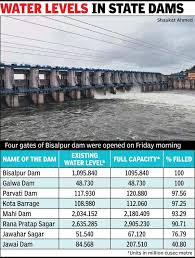Understanding Bisalpur Dam and Its Role in Rajasthan

Introduction
The Bisalpur Dam, located in the Ajmer district of Rajasthan, is a pivotal structure for the region’s water supply and agricultural sustainability. Built on the Banas River, the dam serves as a vital source of drinking water to various towns and cities, including Ajmer and Beawer. The importance of the Bisalpur Dam has grown over the years, particularly in light of the ongoing challenges related to water scarcity in this semi-arid region.
History and Construction
Constructed between 1976 and 1988, the Bisalpur Dam was designed to harness the water of the Banas River, with a total capacity of approximately 370 million cubic meters. Its primary purposes include irrigation and drinking water supply. The dam’s reservoir plays a significant role in recharging groundwater and supporting the irrigation needs of the agricultural belt surrounding it.
Recent Developments
In recent months, the Bisalpur Dam has garnered attention due to unusual rainfall patterns in Rajasthan. The monsoon season of 2023 has brought significant rainfall, leading to an increase in the reservoir’s water levels. However, it has also raised concerns about flood management and the safety of communities living downstream. The local government, in collaboration with the water resources department, has been vigilant in monitoring the situation to prevent any potential flooding issues.
Impact on Agriculture and Water Supply
The dam’s role extends beyond merely providing drinking water; it is fundamental to agricultural practices in the region. Farmers rely on water from the Bisalpur Dam for irrigation, particularly during the kharif sowing season. The consistent water supply is essential for crops like wheat, barley, and pulses, directly influencing the local economy and food security.
Environmental Considerations
While the Bisalpur Dam serves various functions, it also raises environmental concerns. The alteration of the river’s natural flow can impact local ecosystems and wildlife. Authorities are increasingly prioritizing sustainable practices to balance water needs with environmental health. Initiatives focused on afforestation and soil conservation are being promoted to minimize the ecological impact of dam operations.
Conclusion
The significance of the Bisalpur Dam is evident not only in its role as a water source but also in its broader impact on the region’s agricultural practices and environmental balance. As water scarcity continues to be a pressing issue in Rajasthan, the dam represents both a solution and a challenge. Continued investment in infrastructure and sustainable management practices will be crucial in ensuring that the region can thrive amidst ongoing climatic changes. The future of the Bisalpur Dam will play a pivotal role in shaping Rajasthan’s water security and agricultural productivity.









